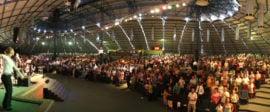The Future for ‘Faith at Work’: A New Zealand Perspective
Academic Paper / Produced by Individual TOW Project member
Most of us spend almost 40 per cent of our waking time at work. In contrast the average Christian spends less than 2 per cent (of his or her time) at church during their working years. Yet the church puts most of its energy into that 2 per cent; almost nothing into the world of work. (Calvin Redekop)
I first came across these words by American Mennonite Calvin Redekop1 15 years ago. They have haunted me ever since. At that stage I had pastored a large suburban Baptist church, helped to replant a small-town congregation and headed up a mission and development agency working among the urban poor in several large Asian cities, while also teaching the theology of mission part time. However, the real challenge came when, in the course of my teaching, I became convinced that a major contributing factor to the declining influence of the church in New Zealand was its failure to apply sound mission principles to the way it operated at home. I came to believe that the church was failing miserably to resource its largest mission force, its own members mobilized every day of the week to interact with people outside the church in their places of work. It seemed that Christians were hardly conscious that a profound missionary encounter was taking place there, nor that the future shape of the church might be decided in that context. This situation then became a personal challenge. What could I do about it?
It seems that David Clark has experienced the same challenge, the same dissatisfaction with the church as just a club or support group for those who are already members, and the same desire to see the people of God contributing good things to the life of the world. In David Clark's words, this means 'a diaconal church that liberates its laity to model and build communities transformed by the gifts of the kingdom community'.2 However, when you start thinking like this, you find yourself on a journey that leads to a vision of a church with very different priorities, and engaged in a struggle to understand what such a church really looks like.
All this starts innocently enough. As David Clark says: 'A diaconal church has two main forms — the Christian community gathered for worship, learning and caring; the Christian community dispersed to fulfil its mission in the world. '3 Nothing too different or radical about that. But then: 'To equip the laity to be servants of the kingdom community a new form of church leadership is needed.'4 That is different. And then: 'For a diaconal church to fulfil its mission, the mould of Christendom, which continues to embody an anachronistic model of church, rnust be broken. '5 That is revolution!
For me, this challenge has become focused on trying to understand one particular question: 'What is required to resource the people of God for ministry in daily life through their work?' Hence the 'Faith at Work' label in the title of this chapter. For the purposes of this chapter, Faith at Work (FAW from here on) refers to the wider movement and not just to those groups that identify themselves by that title.6
Where have we come from?
The only future that we can predict with any confidence is one growing out of things that we can already see beginning now — contemporary movements that are gaining momentum and continuing a trajectory that other such movements have pointed towards. For this reason we are fortunate that an historical analysis of the FAW movement has begun. David Miller has recently completed an analysis of the history and promise of FAW in America.7 David Clark's Breaking the Mould of Christendom includes a helpful description (Parts 3 and 4) of some models of FAW that have been experimented with in the UK. In New Zealand, Seton Horrill has helpfully traced the history of industrial mission there.8 And I have tracked historical developments in Christian understandings of vocation and the theology of work, with a special focus on the second half of the twentieth century.
Where are we at?
In the 14 years that I have been researching, teaching and writing about faith and work, there has never been as much interest in these issues as there is now. This is evidenced in:
- the publishing boom — as described in Pete Hammond's introduction to The Marketplace Annotated Bibliography9
- the multiplication of different workplace ministries — described in the Preface to the International Faith and Work Directory10
- increasing interest in teaching courses related to faith and work issues — as listed in the International Faith and Work Directory11
- growing academic interest within the business academy12
The four most interesting recent developments that I note include: the rapid multiplication of faith at work groups; the increasing involvement of Christians from evangelical and Pentecostal church backgrounds; gradually increasing interest in faith at work in academic circles; and a fascination with spirituality and work in the wider culture outside the church. I suggest that all these trends will continue in the near future. But where is FAW going? And what will be the most influential forces that shape its future?
My answer to this question revolves around a series of other questions. How these questions are answered will determine the future for the FAW movernent. It is these questions that shape the rest of this chapter.
Where are we going?
The churches — can they help?
Many of the FAW ministries that grew in the twentieth century were developed with the support and involvement of churches engaged in the ecumenical movement. The rapid multiplication of workplace ministries that is now occurring around the world is largely the work of parachurch ministries and entrepreneurial business people. Many such initiatives are born out of frustration with the inertia of the churches. Some of its proponents view present churches as more of a hindrance than a help to ministry in daily life. Church leaders are easily upset and afienated by this sort of rhetoric. And the situation becomes more complicated when workplace ministries start to function as alternatives to church.
At the same time many other advocates of FAW are happy to work with quite traditional expressions of church. Some have sought recognition and ordination in these churches. And many suggestions are made about what existing churches can do to enhance ministry in daily life.13
Some, like Australian Robert Banks, are convinced 'the church in the home' provides the best way to help people integrate faith and daily life.14 For Banks, large, formal congregational gatherings create a world apart from the rest of life and do not allow people to participate in a natural way that encourages them to integrate their faith with the rest of life. Australian James Thwaites15 is disturbed by the way we so strongly identify church with large gatherings. For him, this needs to change even if it means giving church members permission not to gather so that we can explore other ways of being church that place greater emphasis on the importance of our joining God in the more significant work that he is initiating in the world. Some are working with American mega churches,16 though these, by and large, pay only lip-service to FAW or see the workplace as a mission field for evangelization. Other FAW advocates identify more strongly with emerging and missional church approaches.17 There are those who advocate the growth of workplace churches — so-called 'Monday Church'. For David Clark, 'the diaconal church' is the answer.
As long ago as 1958, Hendrik Kraemer said that it would be impossible seriously to pursue a theology of the laity without also addressing questions about the church and structurak issues.18 A serious challenge for the FAW movement in the days ahead is how it will foster a more helpful dialogue between church leaders and FAW practitioners about theologies of church and ministry, and practical strategies that will support ministry in daily life.
These developments raise two important questions: How strong is the resistance to the FAW movement? and What models of church leadership does the FAW movement require? I raise the first question because, in the process of writing my Master's thesis, I assessed a number of formal church attempts since 1945 to establish structures dedicated to resourcing the people of Göd for their ministry in daily life.19 A sobering realization was that, although a lot of people have started down the FAW trail, the desire to see the church more active in the world usually gets overtaken by internal church concerns. This can be seen in the story of the World Council of Churches,20 the post-Vatican Il Roman Catholic Church, the 'Total Ministry' programme of the Angfican Church in New Zealand, and lay ministry movements in many other countries and denominations. The intention to produce resources designed to support the majority of Christians for their ministry in daily life all too often gets derailed by the allocation of money and energy to provide lay leaders for churches currently struggling to support paid pastoral staff.
The second question relates to the crucial role of pastoral leadership and how this is exercised. It is one thing to share a vision of pastoral leaders as the facilitators and enablers of people for their ministry in daily life. It is something else to unpack what this means in practice. David Clark has sought to tackle this issue with his description of what 'a renewed diaconate' would look like.21 David Miller identifies five factors that are related to core aspects of pastoral ministry in general, but need to be related more specifically to the workplace by church leaders. These factors are:
- A ministry of presence and listening in the work sphere, by visiting people in their places of work.
- A ministry of preaching and prayer that intentionally and constructively addresses faith and work issues.
- A ministry of teaching designed to address faith and work issues, also using the experience and expertise of other church members for input. o A ministry of personal integration that ensures that church members are trained to utilize personal prayer and devotional study in their daily lives.
- A ministry of gatherings of business people (and other workers?22), perhaps in partnership with marketplace ministries. David Miller comments, 'My research has found that lay-led and lay-founded groups are generally more effective at understanding and meeting workplace integration needs. '23
William Diehl says something similar:
The key to bringing the workplace into the worship place is the pastor. If he or she has to have tight control over everything, it will not happen. There are two reasons why the pastor should not totally try to control: very few pastors have the breadth of knowledge of workplace issues to be able to design educational programs of relevance. Secondly, lay leadership must be involved in both the planning and presentation of programs in order to give them credibility in the eyes of the rest of the congregation.24
Is our work primarily about evangelism, or is it meaningful in itself?
I have been involved in many FAW breakfasts, lunches and seminars in New Zealand, Australia, Britain and America and other international gatherings. It is fascinating to experience the different forms they take. But the clearest dividing line relates to whether people feel that their primary role in the workplace is for evangelism.
My survey work has revealed that many Christians, unless they are involved in the helping professions, do not believe that their daily work is of intrinsic worth to God and, therefore, meaningful in itself.25 For most Christians from evangelical and Pentecostal backgrounds, for example, work is God's way of getting us out into the world to connect with non-Christians so we can, first, make converts, and second, make money to support our families and Christian ministries. Some of the strongest advocates for FAW have been evangelistic organizations such as the Billy Graham Association in America, and Workplace Alpha in the UK. For these groups, work is primarily of instrumental importance as measured in terms of witnessing opportunities.
On the other hand, there are groups trying to assert the intrinsic worth of work as part of our participation in the continuing work of God in the world. These groups are exploring the theology of work, ethics for the workplace, spirituality at work, work—life balance, business and community development, working for justice and peace and the integrity of creation, and related issues. There will continue to be a tension between these two perspectives, particularly if Christians from evangelical and Pentecostal backgrounds begin to outnumber others in the FAW movement.
David Miller's observations about the four different doors he sees people walking through to explore the integration of faith and work provide a helpful starting point for examining some of these issues. Miller identifies Evangelism, Ethics, Experience and Enrichment as four different starting points, and pictures these as four quadrants in his socalled 'Integration Box'.26 Outside this 'Box' faith and work are disconnected. Inside the 'Box', one quadrant, Evangelism, is often the starting point, although others may be explored in the process of seeking a more holistic integration of faith and work. I am certain that Evangelism will remain a major concern of the FAW movement, particularly for those from evangelical and Pentecostal backgrounds, although even here, understandings of what evangelism means and involves continue to be debated. But what priority will Miller's other three 'Es' have, and how much will the intrinsic worth of work be affirmed?
Does being a Christian make a difference?
Robin Gill and others who have examined the results of values surveys in Britain, Europe, Australia and New Zealand, have demonstrated quite clearly that churchgoing does make an ethical difference.27 Yet, according to these surveys, this is only with regard to a few issues of personal morality and not very often to wider ethical considerations in business, the environment and government.28 Christian Scharen argues that there is not the neat linear relationship that Gill suggests exists between church liturgy and ethics. Rather, the distinctive ethical perspective of church members is a product of communal identity which means that 'liturgy and its enactment are infused with the particular cultural and social characteristics of membership and location '.29 Whatever the case, Gill's work (supported by Webster and Perry's observations in New Zealand) suggests that, at the moment, apart from emphasizing the need for personal honesty, sexual integrity and warnings about the dangers of greed, most church communities do not show much concern about work issues or business ethics. Nor do justice issues and wider social ethics, or environmental ethics, appear as significant concerns for the majority of Christians in these surveys. It would thus seem to be high time for churches to consider strategies that will expand the range of the FAW issues their members address.
I find myself deeply disturbed by the fact that Kenneth Lay, CEO of Enron, and Bernard Ebbers, CEO of WorldCom, were both apparently devout Christian men and actively involved in their local churches.30 Yet they presided over companies in which enormously corrupt cultures were created. This would seem to be one consequence of relating faith to a small range of personal ethical issues and ignoring the rest. Going to church does make an ethical difference, but not nearly as much difference as it could if broader faith and work issues were more regularly identified and explored in church life.
Is FAW just a white-collar movement?
Christian people I talk to have quite different perspectives on faith and work issues, depending on whether their starting point has been involvement in industrial mission or an attempt to support business and professional people. For example, a major influence in shaping churches' responses to workplace issues in the second half of the twentieth century Initially these chaplains were from the mainline denominations. They were mostly ordained men with strong social consciences who emphasized God's special concern for the poor, the exploited and vulnerable. They saw their role as both pastoral and prophetic. The latter function came to the fore as the post-war boom was replaced by the threat of unemployment, as industries underwent widespread restructuring and jobs for blue-collar workers were harder to find. Many of these chaplains were severe critics of capitalism. Whether or not it was for this reason, my recent survey work suggests that clergy of mainline churches are still perceived by the private sector as holding negative views about business.31 A much higher percentage of workplace chaplains in New Zealand are now lay men and women, many of whom come from evangelical and Pentecostal churches.
There is also a rapid multiplication of other marketplace ministries taking place. Some are church based, but most are parachurch and only rarely connected to the older ecumenical networks. These new expressions of FAW are often not even aware of other historical precedents.
If the recent FAW movement prospers at the expense of traditional industrial mission, will the concern for blue-collar workers be lost? David Miller suggests that this new movement is largely focused on ministry among business people, though, for him, this group includes professions such as medicine, law and accounting. One of the things that may well challenge this situation in New Zealand is the strength of Pacific Island churches which are more blue collar than white collar. Another may be the rise of churches among the disadvantaged in the developing world, and immigrant communities in the West that will remind us of the prophetic and advocacy obligations that go with being rich Christians in a poor world. If we lose that vision for industrial mission and end up only caring pastorally for the white-collar worker, we will have ignored gospel imperatives.
One area in which industrial mission in New Zealand has largely failed is in using the experience of its chaplains to challenge the church to respond to issues confronting all those engaged in the world of work. For the Interchurch Trade and Industry Mission in New Zealand this was one of its four primary objectives, about which Seton Horrill in his history of the organization concluded:
The chaplains' statistical returns show hundreds of indepth conversations on faith/work concerns every day... ITIM through its chaplaincy team is making a vital contribution in 'coal face' theology. However, this massive exposure in faith and work dialogue has not been taken further than a one-to-one encounter. Nor has it been the seed bed for growth into the formal Christian education programme of the Mssion's member churches. In fact I am not aware of any suggestions or attempts to do so.32
It is not too late to take up this challenge. There are still many chaplains with tales worth telling, and important lessons for churches to learn from these stories. Listening to these would ensure that the stories heard in church are not just those of church members. We rnust work hard to keep attuned to what is happening outside the church. To nurture a missional mindset we need to listen more attentively to stories from the edge. Industrial chaplains can provide a valuable source of such tales and perspectives.
Is it possible to pray in the 'fast lane'?
Our search is for a spirituality that offers a more personal sense of connection with God through our work. Those involved in this quest echo the sentiments expressed in Brother Lawrence's Practising the Presence of God, but they also wonder if his experience in a monastery kitchen can be translated into the modern marketplace. Sometimes this search is prompted by the need to find peace and calm in the midst of very stressful circumstances. Or to find healing where there is hurt. Or purpose in the midst of boredom. Or clarity in the midst of chaos.
The problem is that most of our approaches to prayer are 'retreating' models. Is prayer in the 'fast lane' an impossible dream? Does it really require week-long retreats and physical escape? What might an everyday spirituality look like? I do not see this need going away. Indeed, browsing the 'Inspirational' section of my local bookshop suggests that the Dalai Lama and certain New Age groups are often doing a much better job in addressing these issues than Christians, although there are some important exceptions.33
How can we develop our understanding of work?
Until recently there has been a big gap between those resources produced by academics and largely read by academics, and those produced by practitioners for popular consumption, but often without much biblical or theological content. How will biblical literacy and theologizing be encouraged at the grass roots? And how will the theologizing of academics become better grounded and more accessible?34
There are dangers in affirming the intrinsic value of work if this is too closely identified with paid work and not accompanied by a strong doctrine of grace. Western culture has done a good job of idolizing employment and careers by encouraging us to find our identity, status, significance and security through work. A biblical view of work makes plain that only in God can these things be found. Work is not how we earn or confirm our salvation, but it is the primary way we live out our discipleship. Faith and work are not the same, but they cannot be separated.
It is as partners in God's work that we find meaning. This includes the work of the Father, Son and Spirit. However, many Christian groups emphasize the work of one member of the Trinity at the expense of the others.35 They can also stress personal at the expense of social and environmental ethics.36 Grasping a sense of God's bigger picture is so important if we are to avoid promoting simplistic half-truths.
The rapidly growing groups of Christian business people in the present FAW movement is challenging theologians to develop a more positive view of business. This is necessary. But this should not negate a critical evaluation of capitalism. There are those in some FAW circles today promoting an unbalanced prosperity teaching, and related ethical perspectives, which need to be critiqued. A healthy dialogue can still include such criticism. But such dialogue must be built on mutual respect and understanding that comes through a willingness to talk and listen carefully to one another. The 'Theology of Work Project' is one international attempt to produce resources by promoting this kind of debate.
Conclusion
There is currently a widespread and growing FAW movement, in the true sociological sense, developing across every continent. However, it includes a diverse array of people from different backgrounds, with different starting points and different goals and adopting quite different approaches to FAW issues. It also includes those beyond as well as within the Christian churches. What all who are involved in this movement have in common is dissatisfaction with the way that faith and work remain divided and compartmentalized. There is a shared longing to live more integrated lives in a way that challenges the dualisms that separate sacred and secular, private and public, spiritual and physical.
It is also clear that there is a breakdown in understanding between those exploring faith and work issues within academic circles or as church leaders, and those seeking to live out their faith in their daily work. Even among workers themselves, the experience of business people and professionals and of blue-collar workers, as well as that of women and men, differs considerably. Yet it is vital that these diverse groups share their insights and experiences and learn from each other.
Furthermore, as David Miller notes, a great deal will be lost if the grass-roots FAW movement develops in isolation and fails to engage with the ideas of the academy and the structures of church.37
'Breaking the mould of Christendom' will depend on more and more people moving between these diverse groupings and developing new understandings, creative strategies and fresh structures. That more Christians will start to take the challenge of FAW more seriously is certain. Yet I wish I felt more confident that David Clark's vision of 'the liberation of the laity' will become a reality, and that the church as a whole will start to reshape its life and priorities in response to the FAW challenge.











